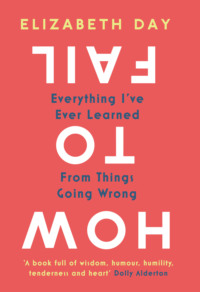
Полная версия
How to Fail: Everything I’ve Ever Learned From Things Going Wrong
‘… the time my friend Simon and I lost the final of the over-40s doubles and had to be content with the runner-up glassware.
‘At cricket, I remember once getting out when I had made 98 and chipped a return catch to the bowler …
‘One of my books was shortlisted for the Bancarella, a big prize in Italy, but did not win (the prize to the brother-in-law of the chairman of judges).
‘And of course there was an embarrassing setback when my famous soufflé à la nage d’homard rose a mere 288mm instead of the desiderated 290.’
He was joking, of course, and when I did interview him for the podcast he spoke eloquently about his periods of depression and feeling as if he didn’t fit in at school. The point he had been trying to make was a serious one, however: it was that failure was all a matter of how you looked at it. On coming second in the Italian literary prize, for instance, he said: ‘Is that a failure? I mean, I wouldn’t have thought so, I thought it was rather a success to be going to Milan to be celebrated in a country not your own for a book with no Italian connection.’
The author James Frey had a similar take, despite the fact that he was publicly outed for fabricating parts of his 2003 debut, A Million Little Pieces. The book, which had originally been marketed as a memoir, did not suffer from his notoriety and became a global bestseller.
‘I don’t look at things that other people might consider failures as failures, it’s just a process, right?’ he said. ‘And you can either handle it or you can’t. If you can’t, get out. But I don’t look at all the books that I tried to write before A Million Little Pieces that I threw away that were no good, as failures, I just look at them as part of the process.’
To this day, Frey said, his mantra is: ‘Fail fast. Fail often.’ It’s a mantra that holds great weight in the (male-dominated) entrepreneurial world too, where risks have to be taken in order to think differently. In this sphere, failure is not only accepted but sometimes even celebrated. There are certain venture capitalists who won’t even think of parting with their cash unless an entrepreneur has failed with a start-up company at least once – the idea being that the entrepreneur will have learned from that failure, will have got all the mistakes out of their system, and will therefore present a sounder investment. Thomas Edison, after all, went through thousands of prototypes before perfecting his light bulb. Bill Gates’ first company was a failure. Over his career in major-league baseball, Babe Ruth set a new record for striking out 1,330 times but also set the record for home runs, hitting 714.
When asked about his batting technique, Babe Ruth replied: ‘I swing as hard as I can … I swing big, with everything I’ve got. I hit big or I miss big. I like to live as big as I can.’
What Babe Ruth was essentially saying was this: that in order to succeed on a grand scale, you have to be willing to fail on an equally grand scale too. Often the former relies on the latter, which is why failure can be integral to success, not just on the baseball field, but in life too.
What does it mean to fail? I think all it means is that we’re living life to its fullest. We’re experiencing it in several dimensions, rather than simply contenting ourselves with the flatness of a single, consistent emotion.
We are living in technicolour, not black and white.
We are learning as we go.
And for all the challenges that come our way, I can’t help but continue to think: it really is an incredible ride.
Конец ознакомительного фрагмента.
Текст предоставлен ООО «ЛитРес».
Прочитайте эту книгу целиком, купив полную легальную версию на ЛитРес.
Безопасно оплатить книгу можно банковской картой Visa, MasterCard, Maestro, со счета мобильного телефона, с платежного терминала, в салоне МТС или Связной, через PayPal, WebMoney, Яндекс.Деньги, QIWI Кошелек, бонусными картами или другим удобным Вам способом.






